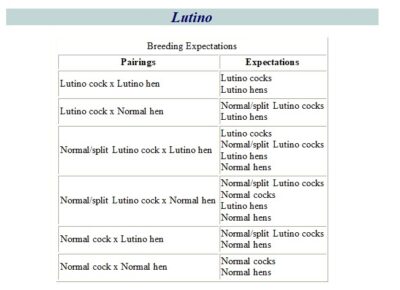
Lutino Budgies/Budgerigar
During the latter half of the nineteenth century, several reports came to light regarding the Lutino Budgerigar mutation. This fascinating mutation features a red eyed self coloured bird. However, breeders quickly lost the mutation, possibly due to a lack of necessary knowledge of breeding patterns. Fortunately, it reappeared and was firmly established simultaneously in England, Europe, and Australia during 1932/36. To that end, the Lutino budgie is an extremely popular mutation, as the almost pure yellow budgies are very eye catching.

Image Courtesy of Rod Turnbull and the ANBC
The Lutino gene is the Ino gene in the form of a green series bird. In a blue series bird, the Ino would be expressed as an Albino (White). The Ino factor suppresses all colours (except white), so that the birds in the green series are pure yellow and have the characteristic pink eyes. Inhibition of melanin production removes the budgie’s black markings and green colors and causes the budgie to become entirely yellow in appearance.
Lutino Budgies – Identification
According to The Standard, the exhibition Lutino budgerigar has a buttercup yellow rump and underparts which are solid and uniform throughout and free of body colour suffusion. The mask is deep and wide (not cleft), extending beyond two large white cheek patches. There are no visible markings on the Lutino budgerigar, they are absent from all areas, the wings corresponding to the body colour. The Lutino tail feathers are approaching the body colour with a white tail quill. The Lutino has a red eye with white iris ring, the legs and feet are pink in colour. The cock has a flesh coloured cere whilst the hen has a brown cere.
The Lutino is not to be confused with the Double Factor Spangle Yellow, a Dark Eyed Clear Yellow, or a Yellow Lacewing. Each has a similar appearance to the Lutino, however distinguishing features differentiate them into separate exhibition classes.
The Spangle Double factor varies from the Lutino on several fronts. Firstly, the feet on a Double Factor Spangle are Grey, and the male has a regular blue coloured cere, versus the pink feet and flesh coloured cere of the Lutino. The Spangle Double Factor also features silvery/white cheek patches, where the Lutino has pure white cheek patches.
The Lacewing is similar to the Lutino in the sense it is a Cinnamon Ino, so it features red eyes and pink feet, however it exhibits strong brown markings.
The Dark eyed clear differentiates from the Lutino through its distinctive full black eye, with no iris ring, whereas the Lutino has the distinctive red eye.

Suggested Pairings to Produce a Lutino Budgie
Suggested pairings include Lutino to Lutino budgies, or a Dark Green Normal split Lutino budgie to a Lutino hen. Taking care to avoid green suffusion on the rump and underparts, breeders use this method to intensify yellow body color. To that end, breeders extensively use olives as a color enhancer also to produce exhibition quality lutino budgies. In general, the double dark factor causes better colour enhancing relative to a single dark factor.
Only a male (cock) can split Lutino due to the sex-linked nature of the gene. A hen is either an Ino, or not.

Click here to view Lutino Breed Expectations in full

- Click here to download Red Eyed Self Lutino Budgerigar (Lutino Budgie)
